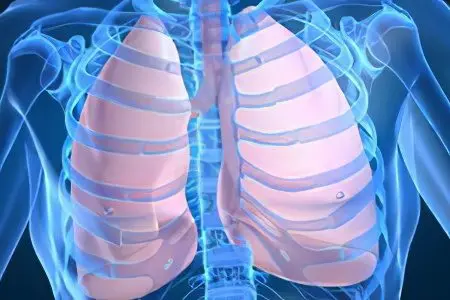Contents

Pulmonary granuloma (also known as pulmonary sarcoidosis) is a benign granulomatosis that occurs with damage to the mesenchymal and lymphatic tissues of various organs, but mainly the respiratory system.
Symptoms of this disease are most often experienced by people of young and middle age (about 20-40 years). In most cases, pulmonary sarcoidosis affects women of this age group. The disease is concentrated in the region of the lungs and, due to the appearance of sarcoid granulomas, which combine into foci of various sizes, has an external resemblance to tuberculosis.
In connection with the accumulation of granulomas, the functions of the lungs are impaired, as a result of which the symptoms of the disease are formed. Ultimately, two options for the outcome of the disease are possible: changes in the fibrous nature in the affected lungs or complete resorption of granulomas.
Causes of the disease
The causes of this disease are still not clear. Currently existing theories cannot fully explain the nature of its origin. Supporters of the infectious theory argue that the causative agents of lung sarcoidosis are protozoa, spirochetes, microbacteria, fungi, or microorganisms of other types. In addition, a number of studies conducted on the scale of the family manifestation of this disease indicate in favor of the genetic nature of the origin of lung sarcoidosis.
A number of modern researchers associate the development of the disease with a violation of the body’s immune response to the effects of endogenous or exogenous (substances of chemical origin, viruses, bacteria) factors. Representatives of certain professions show a certain tendency of morbidity. These occupations include: mechanics, millers, postal workers, health workers, chemical and agricultural workers, smokers and firefighters.
Sarcoidosis is not a contagious disease and is not transmitted from a carrier to a healthy person. In most cases, its multiple organ course is noted. Sarcoidosis of the lungs begins with damage to the alveolar tissue and is accompanied by the development of alveolitis with the further appearance of sarcoid granulomas. Subsequently, the granuloma either resolves or undergoes fibrotic changes, transforming into a cell-free hyaline mass.
Symptoms
In the presence of pulmonary sarcoidosis, non-specific symptoms may occur: fatigue, weakness, anxiety, night sweats, malaise, sleep disturbances, weight loss and appetite. The intrathoracic lympho-glandular form of lung sarcoidosis in half of the patients may be asymptomatic, in other patients there are such clinical manifestations as pain in the joints and chest, weakness, fever, cough. The mediastinal-pulmonary form of the disease passes against the background of pain in the chest area, shortness of breath, cough.
On auscultation, scattered dry and moist rales, crepitus are heard. Other manifestations also occur: eyes, skin, bones, parotid salivary glands, and peripheral lymph nodes are affected. The pulmonary form of sarcoidosis is characterized by the presence of cough with sputum, shortness of breath, chest pain. Preventive measures to combat sarcoidosis have not yet been developed, since the causes of the disease are not clear.
Prevention may consist in minimizing the impact of occupational hazards on the body (especially in high-risk occupations) and strengthening immunity.









